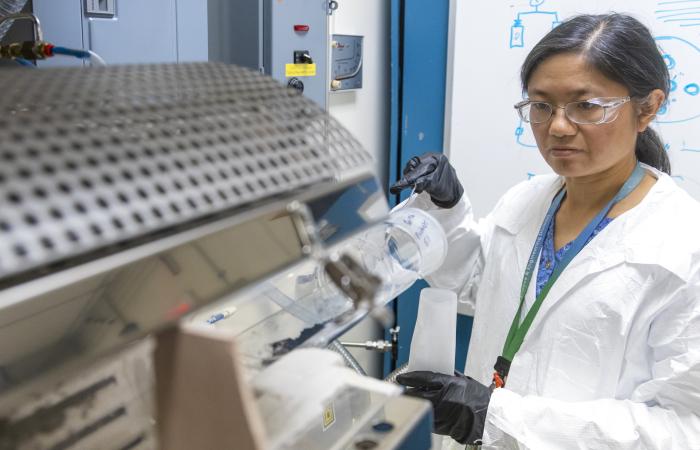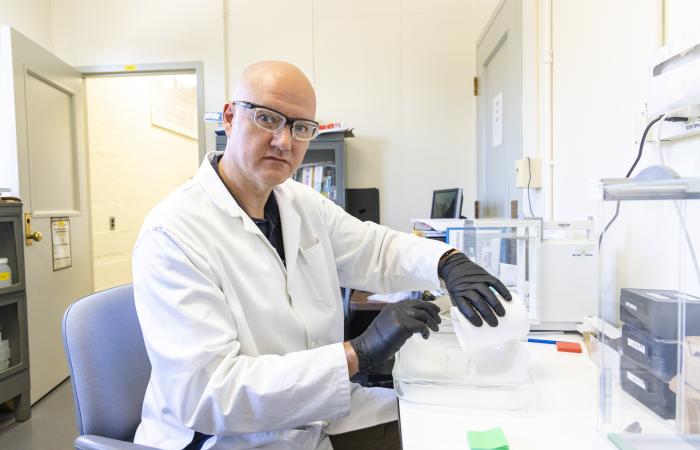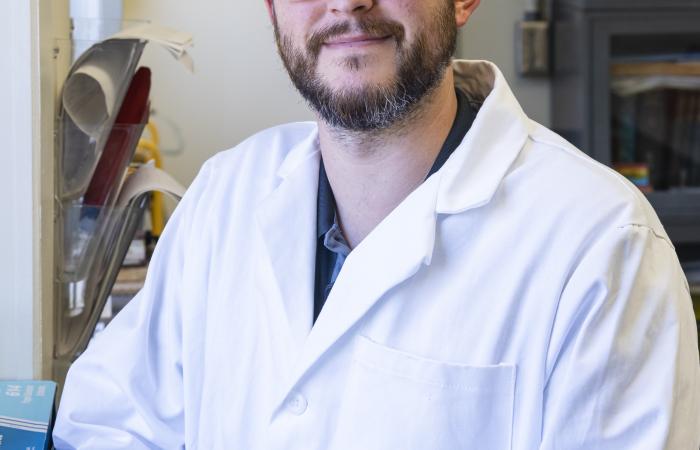Stable isotope team members learn from, depend on one another
Forty years ago, Claude Sampson learned about chemical separations from men who had decades of knowledge simply stored in their heads.
Now that Sampson is the senior support for his team in the Enrichment Science and Engineering Division’s Stable Isotope Materials and Chemistry Group, he doesn’t want to put that much faith in his own memory. He shares his knowledge verbally and in written documents.
And he values the close — almost familial — relationship he has with younger chemists in his group, just as he had with his older colleagues when he was starting out.
“I knew a number of people who worked here during the war, and it was fascinating to hear some of the things they knew,” said Sampson, who first worked at the lab from 1977-1979, then returned in 1986 to work at the Y-12 calutron facility. “The five people I worked with had a combined 150 years of experience in chemistry. The youngest one was 25 years older than me. I knew people who actually helped build some of the buildings, then came there to work.”
As computers became prevalent and the safety culture around the disposal of waste grew, “I ended up doing a lot of that stuff because the older guys just didn’t want to fool with it,” he said. “You come in, and you see these people who have been here 30, 35 years, and you say, ‘I’ll never last that long!’ And the next thing you know, you’ve been here 30 years.”
‘A lot of these things are not in a book’
Sampson joined ORNL’s analytical chemistry division in 1977, then moved to the solid state division, which did a lot of isotope work at that time. After two years, he left to work for a couple of other chemical companies, but came back in 1986: “I realized this was a much better opportunity — I had a future here.”
From 1986 to 2004, he worked at the Y-12 calutron facility, then returned to the main campus when the calutron facility closed. In 2013, he retired — but within three years, he was back as a subcontractor.
“Most people look forward to retirement, and then when it happens, it’s not as great as you thought it would be,” he said. “There are so many things going on out here, and you go from that to watching TV. I was missing out, and I was glad to come back. Just being here, having firsthand knowledge of the things that are going on out here, is a privilege. I don’t know of any other place like it.”
An American Indian, Sampson grew up in a North Carolina farm town that was, he said, smaller than the lab, with a population of about 2,000. His love of chemistry started early.
“I was always just fascinated that you could mix two clear liquids together and it would turn out pink, that you could take two liquids and end up with a solid,” he said. “It’s fascinating, some of the things that happened, and I wanted to learn how and why. I’m still learning. I learn stuff every day.”
Sampson initially learned from textbooks that predated World War II — and from watching his older colleagues and asking questions. In those days, “if we saw an improvement, we made the improvement and just kept on going,” he said. “Those guys knew what to do, and they just assumed the next person would know what to do.”
But Sampson soon realized that a short statement about a complex chemical separation process would lose its context over time, as new people came in and new discoveries were made. When his group began writing procedures down step by step, he said, some of them went from two pages to more than 10.
“When I was younger, I thought I could remember everything forever, but five years later, I can’t even remember doing some of this stuff,” Sampson said. “Now we can document it electronically, so it’s easier to find things. But a lot of this stuff is hard copy because we didn’t have computers. Some of it is packed away in storage. I know where a lot of stuff is, and I remember. Sometimes you don’t even realize what you know until somebody asks the right question, and then you remember something somebody told you 30 years ago.”
Suree Brown, a native of Thailand who joined ORNL in 2019 after working as a research associate in Dr. Sheng Dai’s University of Tennessee lab, said she relies on Sampson’s experience often.
“I have great respect for him and the wealth of knowledge that he has, because a lot of these things are not in a book,” Brown said. “He has the hands-on knowledge from people, and little tips — what precursor to use, how to prevent contamination. There are many things he had to repeat many times. He is patient.”
For example, mercuric oxalate can be explosive when heated, which the newer chemistry texts don’t even mention.
“Of course, I learned it from a fellow who found out firsthand that it explodes,” Sampson said. “You try to remember things that could hurt you. A lot of things in science come from accidents, but you don’t want to be the one to have that accident. You learn from your own mistakes, but you want to learn from other people’s mistakes when possible.”
Stable isotope processing chemist Scott Moeck joined the lab in the fall of 2020 to work with electromagnetic isotope separation equipment but moved to Sampson’s team in the summer of 2021.
A native of a small town in Oregon, who was in the Navy and traveled during a 20-year career working at commercial nuclear power plants, Moeck had the chemistry experience to contribute.
“It’s been really helpful to have Claude’s experiential knowledge,” Moeck said. “Throughout my career, I’ve learned from people who knew things not necessarily written down but who had all these experiences.”
Jason Lang, the youngest team member, joined as a stable isotope processing chemist in December 2021. Lang said he had little previous chemistry experience with many of the elements the team routinely handles.
“Claude is always willing to talk and help with any questions I have, and since he is a bank of knowledge, I try to absorb as much information from him as possible so that I can help pass this info on to the next set of chemists who come to work in our organization,” Lang said. “Suree is the same way, and she has a lot of analytical experience with instruments I’ve wanted to learn. I just tag along with her whenever she uses an instrument I’ve never used before so I can gain some knowledge about the technique.
“We are always willing to help further each other’s capabilities because we know that as we do that, we become a stronger unit for our mission to produce highly pure enriched stable isotopes for the scientific community.”
Valuable materials, valuable bonds
Sampson said the most important thing he’s learned is the value of the stable isotopes his team works with.
“We separate more than 50 elements into individual isotopes, and we’re the only place in the world that produces most of these stable isotopes,” he said. “A lot of effort and materials go into enriching what we work with. Our material is much more expensive than the so-called ‘precious metals.’ And they’re a lot more valuable, too — a lot of the things we produce are used for cancer treatments and diagnosis, for example. Working in the lab, we don’t even know all the things they could be used for. New things are being discovered every day.”
That’s why he’s encouraged to see quality people coming on to his team, to carry forward the work he’s devoted his career to trying to improve on. These days, he noted, they publish their discoveries, besides passing them on organically.
“I always figure everybody’s smarter than me; I know things they don’t know, but that’s just the experience I’ve had,” Sampson said. “Scott has taken over the ytterbium program, as well as silicon, and done a great job. Suree has advanced the things I know because she has more experience in instrumental analysis.”
With Lang, they work well as a team, collaborating on a daily basis.
“We work together to come up with new solutions to all the unique problems we run up against,” Moeck said. “A lot of the chemistry we’re doing is barely touched on in the textbooks; it involves elements at the bottom of the periodic table that people don’t usually see or work with. There’s no manual to go find out where to do this, so we have to come up with an experimental plan together, put it together and try it.”
That bond exists outside the lab, too. Lang, Moeck and Brown all have birthdays very close together, which the team celebrates, and they recently rejoiced at the birth of Lang’s first child.
"It has been a breath of fresh air, knowing I am working with real, genuine people who care about working as a team and about me as a person,” Lang said.
They also support each other during trying times.
“The way Claude helped me is almost like the way he would help a daughter,” said Brown, describing a particularly difficult time during which she needed assistance with a personal matter. “We have concern for each other outside work. I know they mean it when they tell me to call them if I need help.”
Sampson is happy his team of four people from different generations and different places around the world has that bond in and out of the office. And he’s pleased with their part in continuing to help a crucial program thrive.
“There are hundreds of stable isotopes, and there’s somebody somewhere working on every one of them, trying to find a use for them — and more than likely, they’ll eventually come to use,” he said. “I’m glad to see the program doing as well as it’s doing, and I think it’s going to continue to grow and do well. Maybe one day, I’ll retire again.”
I was always just fascinated that you could mix two clear liquids together and it would turn out pink, that you could take two liquids and end up with a solid. It’s fascinating, some of the things that happened, and I wanted to learn how and why. I’m still learning. I learn stuff every day.









